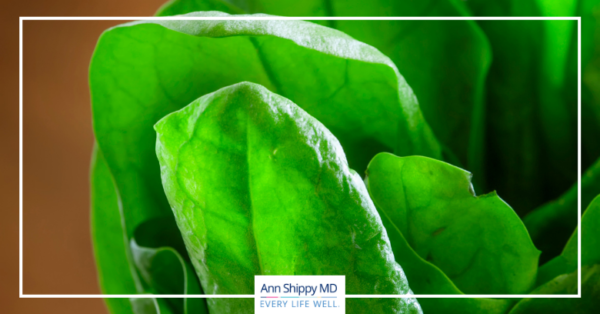Oxalates In Food
In the world of Functional Medicine, best practices involve personalizing the diet for optimal health.
You’ll likely hear about different ways to biohack your daily routine, supplements to add in and practices that will not only help you heal, but also help you thrive.
Through all of this, it’s not uncommon for there to be a lot of confusion about nutrition, and the questions easily get quite specific and nuanced.
One question that comes up frequently is the question concerning oxalates.
Oxalates are a natural component in plant food, and even in Paleo plant foods, that often get a bad rap for inhibiting nutrient absorption, contributing to kidney stones and harming our health.
Instead of being scared about something nature has created, let’s be empowered. Today’s article is going to cover all of your top oxalate questions and leave you feeling even more confident in your diet choices.
In this article, you will learn the answers to these questions, and more:
- What exactly are oxalates?
- Are oxalates really anti-nutrients?
- How do oxalates relate to kidney stones?
- What foods are high in oxalates?
- Do you need to cut out oxalate-rich foods from your diet?
- What can you do to be smart about oxalates?
What Are Oxalates?
Oxalate, or oxalic acid, is a component of plants that give them a bitter flavor and help protect the plant from predators.
Oxalates, alone, are soluble and when they are bound with a mineral, they become insoluble salts that precipitate from water. They are typically bound with sodium, potassium, calcium, iron or magnesium.
When oxalates precipitate in the colon they are excreted along with the minerals they are bound to, but when they precipitate in the urine, they may form calcium oxalate kidney stones, the most common type of kidney stones.
Humans, and other mammals, also produce oxalates as a metabolite of vitamin C. In fact, most of the oxalate in the body is a byproduct of this metabolism.
Are Oxalates “Anti-Nutrients”?
The term “anti-nutrients” refers to compounds that may bind with nutrients in a food, rendering them unavailable for absorption.
Lectins, phytates, goitrogens, tannins, oxalates and others fall into this category and are often discussed in Paleo communities as part of the reasoning behind the avoidance of certain plant foods, including grains and beans.
While grains and beans may be good sources of certain minerals, it can be hard to absorb the minerals due to the anti-nutrient compounds in these foods.
A study looked at the calcium absorption from spinach versus from milk.
Spinach is a rich plant source of calcium, but it is also one of the foods highest in oxalates, whereas milk has high calcium, but no oxalates. (Note there are other reasons to avoid or limit dairy, including the inflammatory nature of dairy products.)
Not surprisingly, the study showed that the absorption of calcium from spinach is lower than from milk, but some calcium was still absorbed.
When the spinach and milk were consumed together, the oxalates didn’t have much effect, showing that pairing high oxalate foods with high calcium, nutrient-dense foods can be supportive.
Oxalates And Kidney Stones
The main reason that there is concern with the oxalates in food is because of kidney stones.
Eighty percent of kidney stones are calcium oxalate stones, meaning that calcium and oxalate bind together in the kidney to form the stones.
It makes sense that reducing dietary oxalate would help those prone to this type of kidney stone, but the science is more nuanced.
First, much of the oxalate that circulates in the body, and is excreted via the kidney, is made in the body.
It’s possible that dietary oxalate accounts for up to 50% of the oxalates that make their way to the kidney, but there are also studies that fail to correlate diets high in oxalates with kidney stone formation.
While the science is mixed, some people have found benefit from reducing oxalates in their diet.
Hyperoxaluria, or high oxalate in the urine, is a risk factor for kidney stones and luckily this can be tested. You and your practitioner can decide if a low oxalate diet is necessary based on test results and other lifestyle factors.
Oxalate Foods List
Oxalates are found, to varying degrees, in whole plant foods.
Many of the foods highest in oxalates are considered healthy foods and may provide important nutrients in the diet. In addition, while we have some data about the amount of oxalates in a certain food, these are just estimates based on testing one food item at one time.
In reality, the amount of oxalates will vary in a food depending on the plant variety, growing conditions, cooking time and temperature and other factors.
For reference, an average person eats around 200 mg of oxalates per day. High oxalate foods typically have over 100 mg for an average serving, and even up to 800 mg per serving.
Foods considered low in oxalates typically have under 4 mg per serving. A low oxalate diet is typically considered reducing oxalates to below 50 mg total for the day.
Below are lists of both high and low oxalate foods. For a more complete list, or to search for a specific food, see a compilation of the data here. (Note that this resource has varying serving sizes for the data).
High Oxalate Foods List:
- Spinach
- Swiss chard
- Amaranth
- Rhubarb
- Soybeans
- Almonds
- Potato
- Beets
- Beans
- Sweet potato
- Taro
- Cacao
- Tea
Paleo Low Oxalate Foods List:
- Cruciferous veggies: broccoli, bok choy, cauliflower, cabbage, kale
- Celery
- Cucumber
- Onions
- Mushrooms
- Radishes
- Zucchini
- Apples, pears
- Apricots, peaches, plums
- Berries: strawberries, blackberries blueberries
- Citrus fruits
- Watermelon
Click HERE or on the image below to download my complete Oxalate Food List
Do You Need To Limit Oxalates In Your Diet?
In short: likely not. Those eating high oxalate foods are often following a diet that is considered healthy, including a Paleo diet.
Oxalates are just one piece of an intricate web of nutrition that makes up a food. We need to consider all of the other components of food and that typically the whole is greater than the sum of its parts.
We also need to consider the individual, their health status, overall diet and eating patterns when deciding if lowering oxalates is appropriate.
Plant foods, especially Paleo vegetables and fruits, are incredibly beneficial for digestion, detoxification, the microbiome, anti-aging and for overall health and wellness. Because of this, it doesn’t make sense to eliminate nutrient-dense foods without reason.
In her review of oxalates, Functional Medicine expert Dr. Deanna Minich and her co-author conclude: “oxalate containing foods possess an array of protective, beneficial compounds which may outweigh any possible negative effects of oxalate.”
Being Smart About Oxalates
As discussed, most healthy people likely do not need to reduce oxalates in their diet.
However, if you are prone to calcium oxalate kidney stones or have another reason where you want to experiment with a lower oxalate plan for a while, here are some pieces to consider:
- Stay hydrated. Kidney stones tend to occur when urine volume is low, so make sure you are drinking enough water every day to flush out oxalates from your body. You might need to pay attention to caffeine and alcohol intake, which is dehydrating, and ditch the soda and other sugary beverages as well.
- Cook high oxalate foods. Both boiling and steaming have been shown to reduce oxalates in food and are especially helpful for veggies with a large surface area such as spinach and chard. One study showed that boiling for 12 minutes, reduced oxalates by around 85% and that steaming reduced by around 45%. The good news is that this reduction is mostly in soluble oxalates, which frees up more minerals from the food for absorption.
- Increase variety. Eat an abundance and diverse amount of mineral-rich plant foods. Arugula, kale and other greens are lower in oxalates than spinach, so don’t get stuck in a pattern where you are only relying on just a few types of veggies. Mix it up! As a fun challenge, try to include 50 different plant foods in your diet every week. Think of veggies, fruits, nuts, seeds, herbs and spices as your main sources.
If you cook spinach you’ll reduce the oxalates, but you’ll also reduce folate, vitamin C and other important nutrients, so you can think about variety in terms of cooking as well.
Include some raw and some cooked veggies in the diet, try new recipes and keep it fun.
For inspiration, check out these healthy, nutrient-dense recipes.
- Support the microbiome. Poor gut health may contribute to increased oxalate absorption. So, instead of simply cutting out the high-oxalate (and often nutritious foods), get to the root cause. A GI MAP stool test and personalized 5R Protocol are incredibly helpful here. As is a daily probiotic. There is also research showing that increasing Oxalobacter fromigenes, a beneficial bacteria that lives in the human digestive tract, may reduce the risk of calcium oxalate kidney stones. Just as we think about variety in our diet, let’s also think about diversity in the gut!
As you can see, oxalates aren’t quite as scary as they are made out to be.
Everything depends on context, and for most people, the benefits of eating vegetables and fruits outweigh any risk of oxalate consumption.
That risk will decrease even more with an overall nutrient-dense diet strategy, good hydration, microbiome support and plenty of variety from day-to-day and week-to-week.
References:
- https://www.mdpi.com/2072-6643/12/10/2929/htm
- https://www.annualreviews.org/doi/abs/10.1146/annurev.arplant.56.032604.144106
- https://pubmed.ncbi.nlm.nih.gov/2801588/
- https://www.ncbi.nlm.nih.gov/pmc/articles/PMC3192488/
- https://jasn.asnjournals.org/content/18/7/2198.long
- https://pubmed.ncbi.nlm.nih.gov/15826055/
- https://www.ncbi.nlm.nih.gov/pmc/articles/PMC2396938/
- https://pubmed.ncbi.nlm.nih.gov/16047945/
- https://www.ncbi.nlm.nih.gov/pmc/articles/PMC8773937/#B21-cells-11-00284
- https://pubs.acs.org/doi/10.1021/jf048128d














